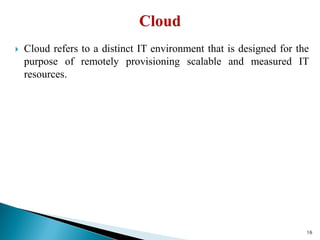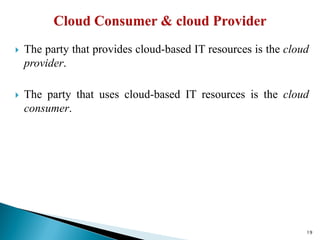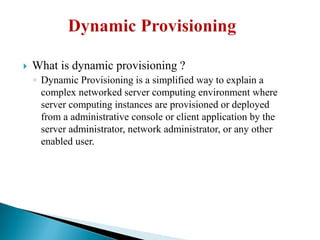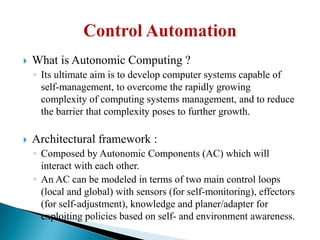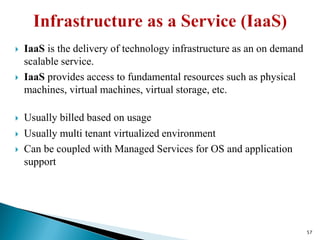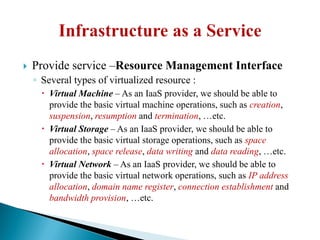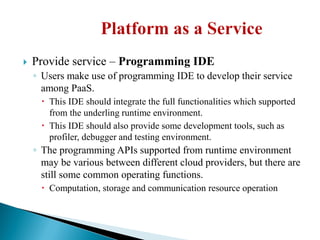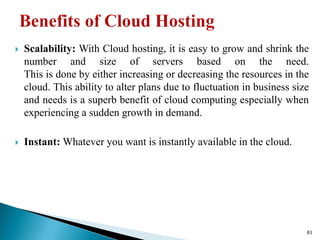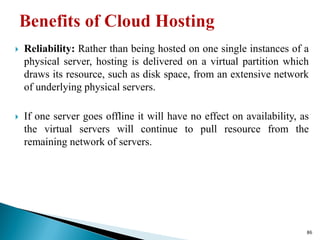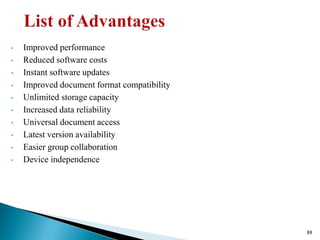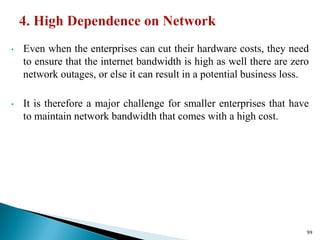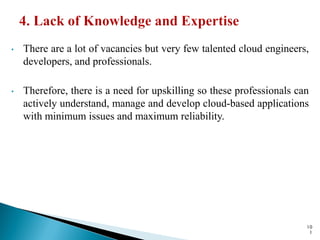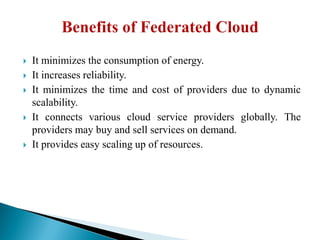cloud computing notes which guide the engineering student
- 1. Origins and Influences, Basic Concepts and Terminology, Goals and Benefits, Risks and Challenges, Roles and Boundaries, Cloud Characteristics, Cloud Delivery Models, Cloud Deployment Models, Federated Cloud/Inter-cloud, Types of Clouds.
- 2. Cloud Computing provides us a means by which we can access the applications as utilities, over the Internet. It allows us to create, configure, and customize applications online. With Cloud Computing users can access database resources via the internet from anywhere for as long as they need without worrying about any maintenance or management of actual resources. 2
- 3. The term Cloud refers to a Network or Internet. In other words, we can say that Cloud is something, which is present at remote location. Cloud can provide services over network, i.e., on public networks or on private networks, i.e., WAN, LAN or VPN. Applications such as e-mail, web conferencing, customer relationship management (CRM), all run in cloud. 3
- 4. Definition from NIST(National Institute of Standards and Technology) ◦ Cloud computing is a model for enabling convenient, on- demand network access to a shared pool of configurable computing resources (e.g., networks, servers, storage, applications, and services) that can be rapidly provisioned and released with minimal management effort or service provider interaction. ◦ This cloud model promotes availability and is composed of five essential characteristics, three service models, and four deployment models.
- 5. Definition from Wikipedia ◦ Cloud computing is Internet-based computing, whereby shared resources, software, and information are provided to computers and other devices on demand, like the electricity grid. ◦ Cloud computing is a style of computing in which dynamically scalable and often virtualized resources are provided as a service over the Internet.
- 6. Definition from Whatis.com ◦ The name cloud computing was inspired by the cloud symbol that's often used to represent the Internet in flowcharts and diagrams. Cloud computing is a general term for anything that involves delivering hosted services over the Internet.
- 7. Definition from Berkeley ◦ Cloud Computing refers to both the applications delivered as services over the Internet and the hardware and systems software in the datacenters that provide those services. ◦ The services themselves have long been referred to as Software as a Service (SaaS), so we use that term. The datacenter hardware and software is what we will call a Cloud. ◦ When a Cloud is made available in a pay-as-you-go manner to the public…… The service being sold is Utility Computing.
- 8. It is a combination of software and hardware based computing recourses delivered as a network service It offers online data storage , infrastructure and application 8
- 9. Cloud Computing refers to manipulating, configuring, and accessing the applications online. It offers online data storage, infrastructure and application. Cloud Computing is both a combination of software and hardware based computing resources delivered as a network service. 9
- 11. Cloud computing is a paradigm of computing, a new way of thinking about IT industry but not any specific technology. ◦ Central ideas Utility Computing SOA - Service Oriented Architecture SLA - Service Level Agreement ◦ Properties and characteristics High scalability and elasticity High availability and reliability High manageability and interoperability High accessibility and portability High performance and optimization ◦ Enabling techniques Hardware virtualization Parallelized and distributed computing Web service
- 13. Perspective from user : ◦ Users do not care about how the works are done Instead, they only concern about what they can get ◦ Users do not care about what the provider actually did Instead, they only concern about their quality of service ◦ Users do not want to own the physical infrastructure Instead, they only want to pay as many as they used What dose user really care ? ◦ They only care about their “Service”
- 14. One service provisioning model ◦ Service provider makes computing resources and infrastructure management available to the customer as needed, and charges them for specific usage rather than a flat rate. ◦ Like other types of on-demand computing , the utility model seeks to maximize the efficient use of resources and/or minimize associated costs.
- 15. Cloud IT Resources On-Premise Cloud Consumer & cloud Providers Scaling Cloud Service Cloud Service Consumer 15
- 16. Cloud refers to a distinct IT environment that is designed for the purpose of remotely provisioning scalable and measured IT resources. 16
- 17. An IT resource is a physical or virtual IT related artifact that can be either software based or hardware based 17
- 18. An IT resource that is hosted in a conventional IT enterprise within an organizational boundary is considered to be located on the premises of the IT enterprise, or on-premise for short. “on-premise” is another way of stating “on the premises of a controlled IT environment that is not cloud-based.” 18
- 19. The party that provides cloud-based IT resources is the cloud provider. The party that uses cloud-based IT resources is the cloud consumer. 19
- 20. Scaling represents the ability of the IT resource to handle increased or decreased usages demands Two types of scaling:- - Horizontal Scaling-scaling out and scaling in - Vertical Scaling-scaling up and scaling down 20
- 21. The allocating or releasing of IT resources that are of the same type is referred to as horizontal scaling The horizontal allocation of resources is referred to as scaling out and the horizontal releasing of resources is referred to as scaling in. 21
- 22. When an existing IT resource is replaced by another with higher or lower capacity is vertical scaling The replacing of an IT resource with another that has a higher capacity is referred to as scaling up and with another that has a lower capacity is considered scaling down. 22
- 23. Cloud Service is any IT resource that is made remotely accessible via a cloud 23
- 24. Service is what you connect together using Web Services. Service is the endpoint of a connection. Functionalities of service : ◦ A service should be well-defined ◦ A service should be self-contained ◦ A service should not depend on the context or state of other services.
- 25. Definition : ◦ Web service is self-describing and stateless modules that perform discrete units of work and are available over the network ◦ Web service providers offer APIs that enable developers to exploit functionality over the Internet, rather than delivering full-blown applications Web Services Description Language (WSDL) : ◦ Expressed in XML which include both data type and messages ◦ Four types of operations : One-way - Messages sent without a reply required Request & response - Sending and replying messages Solicit response - A request for a response Notification - Messages sent to multiple receivers
- 26. Definition ◦ Service Oriented Architecture (SOA) is essentially a collection of services which communicate with each other ◦ Contain a flexible set of design principles used during the phases of systems development and integration ◦ Provide a loosely-integrated suite of services that can be used within multiple business domains Approach ◦ Usually implemented by Web Service model
- 27. Original definition ◦ Quality of Service (QoS) is a set of technologies for managing network traffic in a cost effective manner to enhance user experiences for home and enterprise environments. Now QoS becomes to a broad term that is used following areas : ◦ Customer care evaluations ◦ Technological evaluations
- 28. Customer care evaluations ◦ QoS is usually measured in terms of issues that have a direct impact on the experience of the customer ◦ Only issues that produce a negative effect on the goods and services received by the customer come under scrutiny Technological evaluations ◦ QoS has to do with the efficient operation of various systems ◦ This can lead to adjusting procedures or adapting software programs and code to achieve the desired effect while making a more efficient use of available resources
- 29. Definition ◦ A service-level agreement (SLA) is a contract between a network service provider and a customer that specifies, usually in measurable terms (QoS), what services the network service provider will furnish Common content in contract ◦ Performance guarantee metrics Up-time and down-time ratio System throughput Response time ◦ Problem management detail ◦ Penalties for non-performance ◦ Documented security capabilities Utility Computing SOA + SLA
- 30. The cloud service consumer is a temporary runtime role assumed by a software program when it accesses a cloud service 30
- 31. What is scalability ? ◦ A desirable property of a system, a network, or a process, which indicates its ability to either handle growing amounts of work in a graceful manner or to be readily enlarged. What is elasticity ? ◦ The ability to apply a quantifiable methodology that allows for the basis of an adaptive introspection with in a real time infrastructure. But how to achieve these properties ? ◦ Dynamic provisioning ◦ Multi-tenant design
- 32. What is dynamic provisioning ? ◦ Dynamic Provisioning is a simplified way to explain a complex networked server computing environment where server computing instances are provisioned or deployed from a administrative console or client application by the server administrator, network administrator, or any other enabled user.
- 33. In traditional computing model, two common problems : ◦ Underestimate system utilization which result in under provision Resources Demand Capacity 1 2 3 Resources Demand Capacity 1 2 3 Resources Demand Capacity Time (days) 1 2 3 Loss Users Loss Revenue
- 34. ◦ Overestimate system utilization which result in low utilization How to solve this problem ?? ◦ Dynamically provision resources Unused resources Demand Capacity Time Resources
- 35. Cloud resources should be provisioned dynamically ◦ Meet seasonal demand variations ◦ Meet demand variations between different industries ◦ Meet burst demand for some extraordinary events Demand Capacity Time Resources Demand Capacity Time Resources
- 36. What is multi-tenant design ? ◦ Multi-tenant refers to a principle in software architecture where a single instance of the software runs on a server, serving multiple client organizations. ◦ With a multi-tenant architecture, a software application is designed to virtually partition its data and configuration thus each client organization works with a customized virtual application instance. Client oriented requirements : ◦ Customization Multi-tenant applications are typically required to provide a high degree of customization to support each target organization's needs. ◦ Quality of service Multi-tenant applications are expected to provide adequate levels of security and robustness.
- 37. What is availability ? ◦ The degree to which a system, subsystem, or equipment is in a specified operable and committable state at the start of a mission, when the mission is called for at an unknown time. ◦ Cloud system usually require high availability Ex. “Five Nines” system would statistically provide 99.999% availability What is reliability ? ◦ The ability of a system or component to perform its required functions under stated conditions for a specified period of time. But how to achieve these properties ? ◦ Fault tolerance system ◦ Require system resilience ◦ Reliable system security
- 38. What is manageability ? ◦ Enterprise-wide administration of cloud computing systems. Systems manageability is strongly influenced by network management initiatives in telecommunications. What is interoperability ? ◦ Interoperability is a property of a product or system, whose interfaces are completely understood, to work with other products or systems, present or future, without any restricted access or implementation. But how to achieve these properties ? ◦ System control automation ◦ System state monitoring
- 39. What is Autonomic Computing ? ◦ Its ultimate aim is to develop computer systems capable of self-management, to overcome the rapidly growing complexity of computing systems management, and to reduce the barrier that complexity poses to further growth. Architectural framework : ◦ Composed by Autonomic Components (AC) which will interact with each other. ◦ An AC can be modeled in terms of two main control loops (local and global) with sensors (for self-monitoring), effectors (for self-adjustment), knowledge and planer/adapter for exploiting policies based on self- and environment awareness.
- 40. Four functional areas : ◦ Self-Configuration Automatic configuration of components. ◦ Self-Healing Automatic discovery, and correction of faults. ◦ Self-Optimization Automatic monitoring and control of resources to ensure the optimal functioning with respect to the defined requirements. ◦ Self-Protection Proactive identification and protection from arbitrary attacks.
- 41. What is system monitor ? ◦ A System Monitor in systems engineering is a process within a distributed system for collecting and storing state data. What should be monitored in the Cloud ? ◦ Physical and virtual hardware state ◦ Resource performance metrics ◦ Network access patterns ◦ System logs ◦ … etc Anything more ? ◦ Billing system
- 42. Cloud computing brings many benefits : ◦ For the market and enterprises Reduce initial investment Reduce capital expenditure Improve industrial specialization Improve resource utilization ◦ For the end user and individuals Reduce local computing power Reduce local storage power Variety of thin client devices in daily life
- 43. Reduced Investment & Proportional costs Increased Scalability Increased Availability & Reliability 43
- 45. There are certain services and models working behind the scene making the cloud computing feasible and accessible to end users. Following are the working models for cloud computing: Deployment Models Services Models 45
- 46. Deployment models define the type of access to the cloud, i.e., how the cloud is located? Cloud can have any of the four types of access: Public, Private, Hybrid and Community. 46
- 47. There are four primary cloud deployment models : ◦ Public Cloud ◦ Private Cloud ◦ Community Cloud ◦ Hybrid Cloud Each can exhibit the previously discussed characteristics; their differences lie primarily in the scope and access of published cloud services, as they are made available to service consumers.
- 48. 48
- 49. Public cloud definition ◦ The cloud infrastructure is made available to the general public or a large industry group and is owned by an organization selling cloud services. ◦ Also known as external cloud or multi-tenant cloud, this model essentially represents a cloud environment that is openly accessible. ◦ Basic characteristics : Homogeneous infrastructure Common policies Shared resources and multi-tenant Leased or rented infrastructure Economies of scale
- 50. Private cloud definition ◦ The cloud infrastructure is operated solely for an organization. It may be managed by the organization or a third party and may exist on premise or off premise. ◦ Also referred to as internal cloud or on-premise cloud, a private cloud intentionally limits access to its resources to service consumers that belong to the same organization that owns the cloud. ◦ Basic characteristics : Heterogeneous infrastructure Customized and tailored policies Dedicated resources In-house infrastructure End-to-end control
- 51. Comparison : Public Cloud Private Cloud Infrastructure Homogeneous Heterogeneous Policy Model Common defined Customized & Tailored Resource Model Shared & Multi-tenant Dedicated Cost Model Operational expenditure Capital expenditure Economy Model Large economy of scale End-to-end control
- 52. Community cloud definition ◦ The cloud infrastructure is shared by several organizations and supports a specific community that has shared concerns (e.g., mission, security requirements, policy, and compliance considerations).
- 53. Hybrid cloud definition ◦ The cloud infrastructure is a composition of two or more clouds (private, community, or public) that remain unique entities but are bound together by standardized or proprietary technology that enables data and application portability (e.g., cloud bursting for load-balancing between clouds).
- 54. Service Models are the reference models on which the Cloud Computing is based. These can be categorized into three basic service models as listed below: 1. Infrastructure as a Service (IaaS) 2. Platform as a Service (PaaS) 3. Software as a Service (SaaS) 54
- 55. What if you want to have an IT department ? ◦ Similar to build a new house in previous analogy You can rent some virtualized infrastructure and build up your own IT system among those resources, which may be fully controlled. Technical speaking, use the Infrastructure as a Service (IaaS) solution. ◦ Similar to buy an empty house in previous analogy You can directly develop your IT system through one cloud platform, and do not care about any lower level resource management. Technical speaking, use the Platform as a Service (PaaS) solution. ◦ Similar to live in a hotel in previous analogy You can directly use some existed IT system solutions, which were provided by some cloud application service provider, without knowing any detail technique about how these service was achieved. Technical speaking, use the Software as a Service (SaaS) solution.
- 57. IaaS is the delivery of technology infrastructure as an on demand scalable service. IaaS provides access to fundamental resources such as physical machines, virtual machines, virtual storage, etc. Usually billed based on usage Usually multi tenant virtualized environment Can be coupled with Managed Services for OS and application support 57
- 58. Infrastructure as a Service - IaaS ◦ The capability provided to the consumer is to provision processing, storage, networks, and other fundamental computing resources where the consumer is able to deploy and run arbitrary software, which can include operating systems and applications. ◦ The consumer does not manage or control the underlying cloud infrastructure but has control over operating systems, storage, deployed applications, and possibly limited control of select networking components . Examples : ◦ Amazon EC2 ◦ Eucalyputs ◦ OpenNebula ◦ … etc
- 59. System architecture :
- 60. Enabling technique - Virtualization ◦ Virtualization is an abstraction of logical resources away from underlying physical resources. Virtualization technique shift OS onto hypervisor. Multiple OS share the physical hardware and provide different services. Improve utilization, availability, security and convenience.
- 61. Properties supported by virtualization technique : ◦ Manageability and Interoperability ◦ Availability and Reliability ◦ Scalability and Elasticity
- 62. Provide service –Resource Management Interface ◦ Several types of virtualized resource : Virtual Machine – As an IaaS provider, we should be able to provide the basic virtual machine operations, such as creation, suspension, resumption and termination, …etc. Virtual Storage – As an IaaS provider, we should be able to provide the basic virtual storage operations, such as space allocation, space release, data writing and data reading, …etc. Virtual Network – As an IaaS provider, we should be able to provide the basic virtual network operations, such as IP address allocation, domain name register, connection establishment and bandwidth provision, …etc.
- 63. Provide service – System Monitoring Interface ◦ Several types of monitoring metrics : Virtual Machine – As an IaaS provider, we should be able to monitor some system states of each virtual machine, such as CPU loading, memory utilization, IO loading and internal network loading, …etc. Virtual Storage – As an IaaS provider, we should be able to monitor some storage states of each virtual storage, such as virtual space utilization, data duplication and storage device access bandwidth, …etc. Virtual Network – As an IaaS provider, we should be able to monitor some network states of each virtual network, such as virtual network bandwidth, network connectivity and network load balancing, …etc.
- 64. IaaS is the deployment platform that abstract the infrastructure. IaaS enabling technique ◦ Virtualization Server Virtualization Storage Virtualization Network Virtualization IaaS provided services ◦ Resource Management Interface ◦ System Monitoring Interface
- 65. PaaS provides the runtime environment for applications, development & deployment tools, etc. PaaS provides all of the facilities required to support the complete life cycle of building and delivering web applications and services entirely from the Internet. Typically applications must be developed with a particular platform in mind •Multi tenant environments •Highly scalable multi tier architecture
- 66. Platform as a Service - PaaS ◦ The capability provided to the consumer is to deploy onto the cloud infrastructure consumer-created or acquired applications created using programming languages and tools supported by the provider. ◦ The consumer does not manage or control the underlying cloud infrastructure including network, servers, operating systems, or storage, but has control over the deployed applications and possibly application hosting environment configurations. Examples : ◦ Microsoft Windows Azure ◦ Google App Engine ◦ Hadoop ◦ … etc
- 67. System architecture :
- 68. Enabling technique – Runtime Environment Design ◦ Runtime environment refers to collection of software services available. Usually implemented by a collection of program libraries. Common properties in Runtime Environment : ◦ Manageability and Interoperability ◦ Performance and Optimization ◦ Availability and Reliability ◦ Scalability and Elasticity
- 69. Provide service – Programming IDE ◦ Users make use of programming IDE to develop their service among PaaS. This IDE should integrate the full functionalities which supported from the underling runtime environment. This IDE should also provide some development tools, such as profiler, debugger and testing environment. ◦ The programming APIs supported from runtime environment may be various between different cloud providers, but there are still some common operating functions. Computation, storage and communication resource operation
- 70. Provide service – System Control Interface ◦ Police-Based Control Typically described as a principle or rule to guide decisions and achieve rational outcome(s) Make the decision according to some requirements ◦ Workflow Control Describe the flow of installation and configuration of resources Workflow processing daemon delivers speedy and efficient construction and management of cloud resources
- 71. PaaS is the development platform that abstract the infrastructure, OS, and middleware to drive developer productivity. PaaS enabling technique ◦ Runtime Environment PaaS provide services ◦ Programming IDE Programming APIs Development tools ◦ System Control Interface Policy based approach Workflow based approach
- 73. SaaS model allows to use software applications as a service to end users. SaaS is a software delivery methodology that provides licensed multi-tenant access to software and its functions remotely as a Web-based service. • • • Usually billed based on usage Usually multi tenant environment Highly scalable architecture
- 74. Software as a Service - SaaS ◦ The capability provided to the consumer is to use the provider’s applications running on a cloud infrastructure. The applications are accessible from various client devices through a thin client interface such as a web browser (e.g., web-based email). ◦ The consumer does not manage or control the underlying cloud infrastructure including network, servers, operating systems, storage, or even individual application capabilities, with the possible exception of limited user-specific application configuration settings. Examples : ◦ Google Apps (e.g., Gmail, Google Docs, Google sites, …etc) ◦ SalesForce.com ◦ EyeOS ◦ … etc
- 76. Enabling Technique – Web Service ◦ Web 2.0 is the trend of using the full potential of the web Viewing the Internet as a computing platform Running interactive applications through a web browser Leveraging interconnectivity and mobility of devices Enhanced effectiveness with greater human participation Properties provided by Internet : ◦ Accessibility and Portability
- 77. Provide service – Web-based Applications ◦ Conventional applications should translate their access interface onto web-based platform. ◦ Applications in different domains General Applications – Applications which are designed for general propose, such as office suit, multimedia and instant message, …etc. Business Applications – Application which are designed for business propose, such as ERP, CRM and market trading system, …etc. Scientific Applications – Application which are designed for scientific propose, such as aerospace simulation and biochemistry simulation, …etc. Government Applications – Applications which are designed for government propose, such as national medical system and public transportation system service, …etc.
- 78. Provide service – Web Portal ◦ Apart from the standard search engine feature, web portals offer other services such as e-mail, news, stock prices, information, databases and entertainment. ◦ Portals provide a way for enterprises to provide a consistent look and feel with access control and procedures for multiple applications and databases, which otherwise would have been different entities altogether. ◦ Some examples : iGoogle MSNBC Netvibes Yahoo!
- 79. SaaS is the finished applications that you rent and customize. SaaS enabling technique ◦ Web Service SaaS provide services ◦ Web-based Applications General applications Business applications Scientific applications Government applications ◦ Web Portal
- 81. 81 Networking Networking Networking Networking Storage Storage Storage Storage Servers Servers Servers Servers Virtualization Virtualization Virtualization Virtualization O/S O/S O/S O/S Middleware Middleware Middleware Middleware Runtime Runtime Runtime Runtime Data Data Data Data Applications Applications Applications Applications Client Manages Vendor Manages in Cloud Vendor Manages in Cloud Vendor Manages in Cloud Client Manages Client Manages
- 83. Scalability: With Cloud hosting, it is easy to grow and shrink the number and size of servers based on the need. This is done by either increasing or decreasing the resources in the cloud. This ability to alter plans due to fluctuation in business size and needs is a superb benefit of cloud computing especially when experiencing a sudden growth in demand. Instant: Whatever you want is instantly available in the cloud. 83
- 84. Save Money: An advantage of cloud computing is the reduction in hardware cost. Instead of purchasing in-house equipment, hardware needs are left to the vendor. For companies that are growing rapidly, new hardware can be a large, expensive, and inconvenience. Cloud computing alleviates these issues because resources can be acquired quickly and easily. Even better, the cost of repairing or replacing equipment is passed to the vendors. 84
- 85. Along with purchase cost, off-site hardware cuts internal power costs and saves space. Large data centers can take up precious office space and produce a large amount of heat. Moving to cloud applications or storage can help maximize space and significantly cut energy expenditures. 85
- 86. Reliability: Rather than being hosted on one single instances of a physical server, hosting is delivered on a virtual partition which draws its resource, such as disk space, from an extensive network of underlying physical servers. If one server goes offline it will have no effect on availability, as the virtual servers will continue to pull resource from the remaining network of servers. 86
- 87. Physical Security: The underlying physical servers are still housed within data centres and so benefit from the security measures that those facilities implement to prevent people accessing or disrupting them on-site 87
- 88. • Improved performance • Reduced software costs • Instant software updates • Improved document format compatibility • Unlimited storage capacity • Increased data reliability • Universal document access • Latest version availability • Easier group collaboration • Device independence 88
- 89. • Requires a constant Internet connection • Does not work well with low-speed connections • Features might be limited • Can be slow • Stored data can be lost • Stored data might not be secure 89
- 90. 1. Data Security and Privacy 2. Cost Management 3. Multi-Cloud Environments 4. Performance Challenges 5. Interoperability and Flexibility 6. High Dependence on Network 7. Lack of Knowledge and Expertise 90
- 91. • Data security is a major concern when switching to cloud computing. User or organizational data stored in the cloud is critical and private. • Even if the cloud service provider assures data integrity, it is your responsibility to carry out user authentication and authorization, identity management, data encryption, and access control. 91
- 92. • Security issues on the cloud include identity theft, data breaches, malware infections, and a lot more which eventually decrease the trust amongst the users of your applications. • This can in turn lead to potential loss in revenue alongside reputation and stature. Also, dealing with cloud computing requires sending and receiving huge amounts of data at high speed, and therefore is susceptible to data leaks. 92
- 93. • Even as almost all cloud service providers have a “Pay As You Go” model, which reduces the overall cost of the resources being used, there are times when there are huge costs incurred to the enterprise using cloud computing. • When there is under optimization of the resources, let’s say that the servers are not being used to their full potential, add up to the hidden costs. 93
- 94. • If there is a degraded application performance or sudden spikes or overages in the usage, it adds up to the overall cost. • Unused resources are one of the other main reasons why the costs go up. If you turn on the services or an instance of cloud and forget to turn it off during the weekend or when there is no current use of it, it will increase the cost without even using the resources. 94
- 95. • Due to an increase in the options available to the companies, enterprises not only use a single cloud but depend on multiple cloud service providers. • Most of these companies use hybrid cloud tactics and close to 84% are dependent on multiple clouds. This often ends up being hindered and difficult to manage for the infrastructure team. • The process most of the time ends up being highly complex for the IT team due to the differences between multiple cloud providers. 95
- 96. • Performance is an important factor while considering cloud-based solutions. If the performance of the cloud is not satisfactory, it can drive away users and decrease profits. • Even a little latency while loading an app or a web page can result in a huge drop in the percentage of users. This latency can be a product of inefficient load balancing, which means that the server cannot efficiently split the incoming traffic so as to provide the best user experience. • Challenges also arise in the case of fault tolerance, which means the operations continue as required even when one or more of the components fail. 96
- 97. • When an organization uses a specific cloud service provider and wants to switch to another cloud-based solution, it often turns up to be a tedious procedure since applications written for one cloud with the application stack are required to be re-written for the other cloud. • There is a lack of flexibility from switching from one cloud to another due to the complexities involved. Handling data movement, setting up the security from scratch and network also add up to the issues encountered when changing cloud solutions, thereby reducing flexibility. 97
- 98. • Since cloud computing deals with provisioning resources in real- time, it deals with enormous amounts of data transfer to and from the servers. This is only made possible due to the availability of the high-speed network. • Although these data and resources are exchanged over the network, this can prove to be highly vulnerable in case of limited bandwidth or cases when there is a sudden outage. 98
- 99. • Even when the enterprises can cut their hardware costs, they need to ensure that the internet bandwidth is high as well there are zero network outages, or else it can result in a potential business loss. • It is therefore a major challenge for smaller enterprises that have to maintain network bandwidth that comes with a high cost. 99
- 100. • Due to the complex nature and the high demand for research working with the cloud often ends up being a highly tedious task. • It requires immense knowledge and wide expertise on the subject. Although there are a lot of professionals in the field they need to constantly update themselves. Cloud computing is a highly paid job due to the extensive gap between demand and supply. 10 0
- 101. • There are a lot of vacancies but very few talented cloud engineers, developers, and professionals. • Therefore, there is a need for upskilling so these professionals can actively understand, manage and develop cloud-based applications with minimum issues and maximum reliability. 10 1
- 102. Cloud Federation, also known as Federated Cloud is the deployment and management of several external and internal cloud computing services to match business needs. It is a multi-national cloud system that integrates private, community, and public clouds into scalable computing platforms. Federated cloud is created by connecting the cloud environment of different cloud providers using a common standard.
- 104. 1. Cloud Exchange 2. Cloud Coordinator 3. Cloud Broker
- 105. The Cloud Exchange acts as a mediator between cloud coordinator and cloud broker. The demands of the cloud broker are mapped by the cloud exchange to the available services provided by the cloud coordinator. The cloud exchange has a track record of what is the present cost, demand patterns, and available cloud providers, and this information is periodically reformed by the cloud coordinator.
- 106. The cloud coordinator assigns the resources of the cloud to the remote users based on the quality of service they demand and the credits they have in the cloud bank. The cloud enterprises and their membership are managed by the cloud controller.
- 107. The cloud broker interacts with the cloud coordinator, analyzes the Service-level agreement and the resources offered by several cloud providers in cloud exchange. Cloud broker finalizes the most suitable deal for their client.
- 109. In the federated cloud, the users can interact with the architecture either centrally or in a decentralized manner. In centralized interaction, the user interacts with a broker to mediate between them and the organization. Decentralized interaction permits the user to interact directly with the clouds in the federation. Federated cloud can be practiced with various niches like commercial and non-commercial.
- 110. The visibility of a federated cloud assists the user to interpret the organization of several clouds in the federated environment. Federated cloud can be monitored in two ways. MaaS (Monitoring as a Service) provides information that aids in tracking contracted services to the user. Global monitoring aids in maintaining the federated cloud.
- 111. The providers who participate in the federation publish their offers to a central entity. The user interacts with this central entity to verify the prices and propose an offer. The marketing objects like infrastructure, software, and platform have to pass through federation when consumed in the federated cloud.
- 112. It minimizes the consumption of energy. It increases reliability. It minimizes the time and cost of providers due to dynamic scalability. It connects various cloud service providers globally. The providers may buy and sell services on demand. It provides easy scaling up of resources.
- 113. In cloud federation, it is common to have more than one provider for processing the incoming demands. In such cases, there must be a scheme needed to distribute the incoming demands equally among the cloud service providers. The increasing requests in cloud federation have resulted in more heterogeneous infrastructure, making interoperability an area of concern.
- 114. It becomes a challenge for cloud users to select relevant cloud service providers and therefore, it ties them to a particular cloud service provider. A federated cloud means constructing a seamless cloud environment that can interact with people, different devices, several application interfaces, and other entities.
- 115. OpenNebula Aneka coordinator Eucalyptus
- 116. It is a cloud computing platform for managing heterogeneous distributed data center infrastructures. It can use the resources of its interoperability, leveraging existing information technology assets, protecting the deals, and adding the application programming interface (API).
- 117. The Aneka coordinator is a proposition of the Aneka services and Aneka peer components (network architectures) which give the cloud ability and performance to interact with other cloud services.
- 118. Eucalyptus defines the pooling computational, storage, and network resources that can be measured scaled up or down as application workloads change in the utilization of the software. It is an open-source framework that performs the storage, network, and many other computational resources to access the cloud environment.
- 119. 11 9















